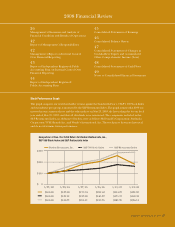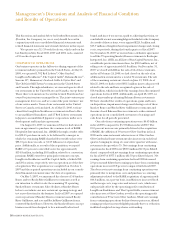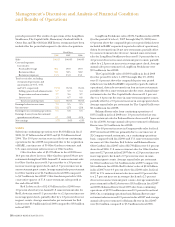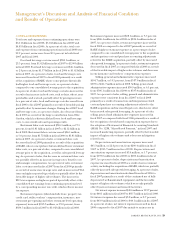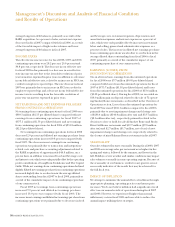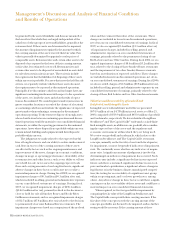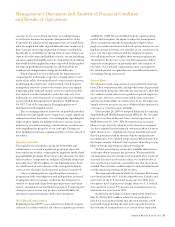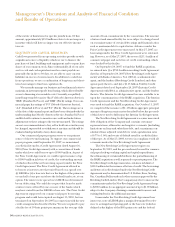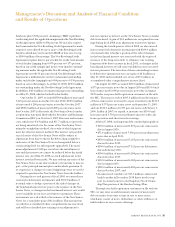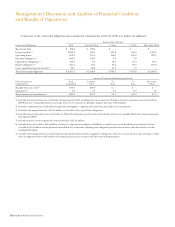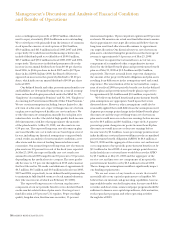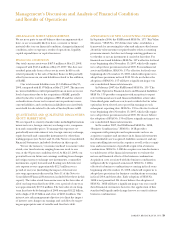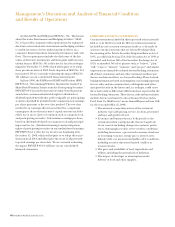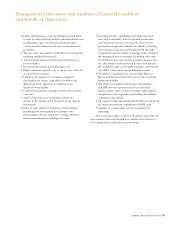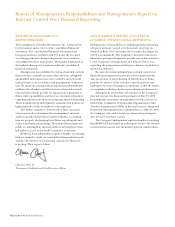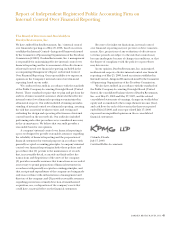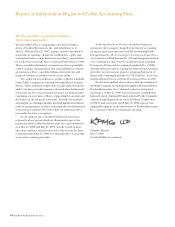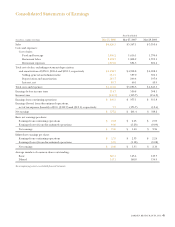Red Lobster 2008 Annual Report Download - page 39
Download and view the complete annual report
Please find page 39 of the 2008 Red Lobster annual report below. You can navigate through the pages in the report by either clicking on the pages listed below, or by using the keyword search tool below to find specific information within the annual report.DARDEN RESTAURANTS, INC. 35
Management’s Discussion and Analysis of Financial Condition
and Results of Operations
funds rate plus 0.500 percent). Assuming a “BBB” equivalent
credit rating level, the applicable margin under the New Revolving
Credit Agreement will be 0.350 percent. We may also request
that loans under the New Revolving Credit Agreement be made
at interest rates offered by one or more of the Revolving Credit
Lenders, which may vary from the LIBOR or base rate, for up
to $100.0 million of borrowings. The New Revolving Credit
Agreement requires that we pay a facility fee on the total amount
of such facility (ranging from 0.070 percent to 0.175 percent,
based on our credit ratings) and, in the event that the outstand-
ing amounts under the applicable New Revolving Credit
Agreement exceeds 50 percent of such New Revolving Credit
Agreement, a utilization fee on the total amount outstanding
under such facility (ranging from 0.050 percent to 0.150 percent,
based on our credit ratings). As of May 25, 2008, $130.0 million
was outstanding under the New Revolving Credit Agreement.
In addition, $48.4 million of commercial paper was outstanding
as of May 25, 2008, which is backed by this facility.
On October 11, 2007, we issued $350.0 million of unsecured
5.625 percent senior notes due October 2012, $500.0 million
of unsecured 6.200 percent senior notes due October 2017
and $300.0 million of unsecured 6.800 percent senior notes
due October 2037 (collectively, the New Senior Notes) under
a registration statement filed with the Securities and Exchange
Commission (SEC) on October 9, 2007. Discount and issuance
costs, which were $4.3 million and $11.7 million, respectively,
are being amortized over the terms of the New Senior Notes
using the straight-line method, the results of which approxi-
mate the effective interest method. The interest rate payable
on each series of the New Senior Notes will be subject to
adjustment from time to time if the debt rating assigned to
such series of the New Senior Notes is downgraded below a
certain rating level (or subsequently upgraded). The maxi-
mum adjustment is 2.000 percent above the initial interest
rate and the interest rate cannot be reduced below the initial
interest rate. As of May 25, 2008, no such adjustments to the
interest rates had been made. We may redeem any series of the
New Senior Notes at any time in whole or from time to time in
part, at the principal amount plus a make-whole premium. If
we experience a change of control triggering event, we may be
required to purchase the New Senior Notes from the holders.
During the second quarter of fiscal 2008, we entered into
treasury-lock derivative instruments with $550.0 million of
notional value to hedge a portion of the risk of changes in
the benchmark interest rate prior to the issuance of the New
Senior Notes, as changes in the benchmark interest rate would
cause variability in our forecasted interest payments. These
instruments were all settled at the issuance of the New Senior
Notes for a cumulative gain of $6.2 million. This amount was
recorded in accumulated other comprehensive income (loss)
and will be reclassified into earnings as an adjustment to
interest expense as interest on the New Senior Notes or similar
debt is incurred. A gain of $0.5 million was recognized in earn-
ings during fiscal 2008 as an adjustment to interest expense.
During the fourth quarter of fiscal 2008, we also entered
into treasury-lock derivative instruments with $100.0 million
of notional value to hedge a portion of the risk of changes
in the benchmark interest rate associated with the expected
issuance of the long-term debt to refinance our existing
long-term debt due to mature in fiscal 2011, as changes in the
benchmark interest rate will cause variability in our forecasted
interest payments. The fair value of these outstanding treasury-
lock derivative instruments was a net gain of $2.3 million at
May 25, 2008 and is included, net of tax of $0.9 million, in
accumulated other comprehensive income (loss).
On August 12, 2005, we issued $150.0 million of unsecured
4.875 percent senior notes due in August 2010 and $150.0 mil-
lion of unsecured 6.000 percent senior notes due in August
2035 under our prior shelf registration statement on file with
the SEC. The net proceeds of $295.4 million from the issuance
of these senior notes were used to repay at maturity our $150.0
million of 8.375 percent senior notes on September 15, 2005
and our $150.0 million of 6.375 percent notes on February 1,
2006. In March 2007, we repaid, at maturity our $150.0 mil-
lion unsecured 5.750 percent medium-term notes with cash
from operations and short-term borrowings.
At May 25, 2008, our long-term debt consisted principally of:
• $150.0 million of unsecured 4.875 percent senior notes
due in August 2010;
• $75.0 million of unsecured 7.450 percent medium-term
notes due in April 2011;
• $350.0 million of unsecured 5.625 percent senior notes
due in October 2012;
• $100.0 million of unsecured 7.125 percent debentures
due in February 2016;
• $500.0 million of unsecured 6.200 percent senior notes
due in October 2017;
• $150.0 million of unsecured 6.000 percent senior notes
due in August 2035;
• $300.0 million of unsecured 6.800 percent senior notes
due in October 2037; and
• An unsecured, variable rate $15.5 million commercial
bank loan due in December 2018 that is used to sup-
port two loans from us to the Employee Stock Owner-
ship Plan portion of the Darden Savings Plan.
Through our shelf registration statement on file with the
SEC, we may issue an indeterminate amount of unsecured
debt securities from time to time in one or more series,
which may consist of notes, debentures or other evidences of
indebtedness in one or more offerings.


